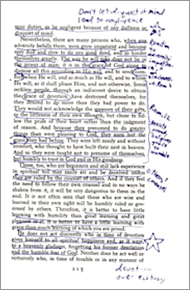Introduction
Experts say that the best readers are “active readers.” But what does that mean? To read well, do you have to read aloud? Should we be jumping about as we read?
What experts mean by active reading is that readers must be thinking actively as they read, with pen, pencil, or marker, or maybe all three in hand. As you read, you should be annotating or making notes in the book. The kinds of notes will vary depending upon the material you are reading. The easier the reading, the fewer the notes you will make.

Source: Annotated text, Peter Stephens, slowreads.com
When you read more difficult material, it’s important to note unfamiliar words, find their definitions, and write them beside the words. To make sure you understand what you read, you need to circle the main idea in each sentence and in each paragraph. You might also want to write questions and come back to the reading to answer those questions or get help from a teacher, or you may just want to have a conversation with the book. Have you ever seen someone get involved in a TV show or commercial and talk back to the TV? Believe it or not, you can have that same kind of interaction with a book.
Good readers underscore or circle important information, write summaries and definitions in the margins, and note questions or disagreements to help them understand and participate in their own reading. This lesson will help you learn effective annotation skills to improve your reading and your test taking.
Here’s a clever poem about annotating called “Marginalia” by poet Billy Collins. The poem is about writing in the margins.